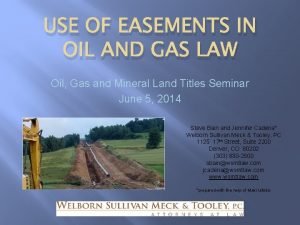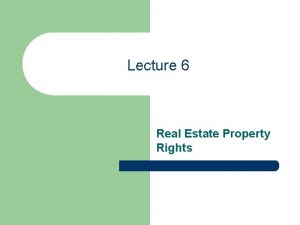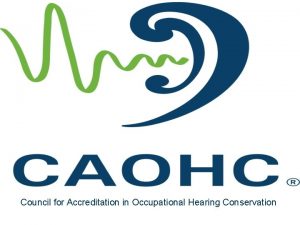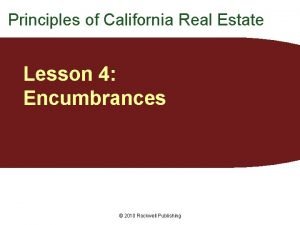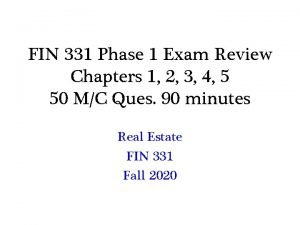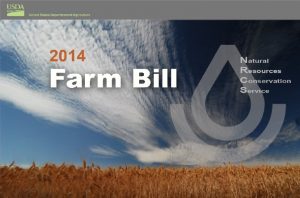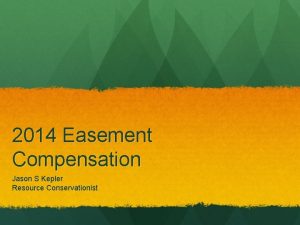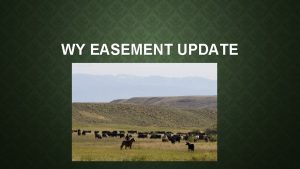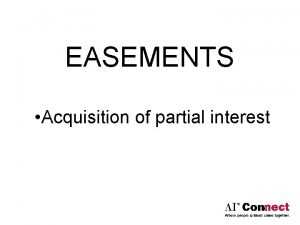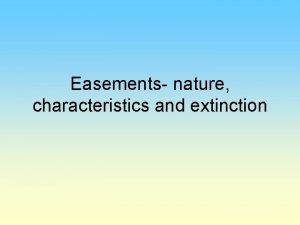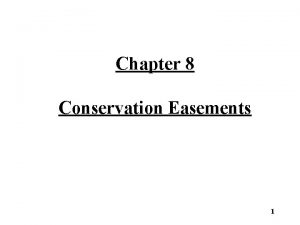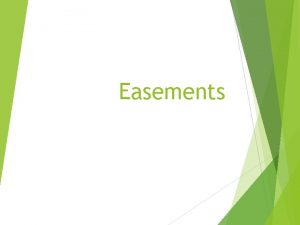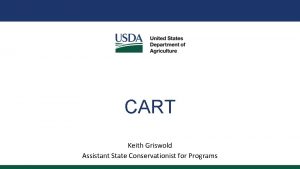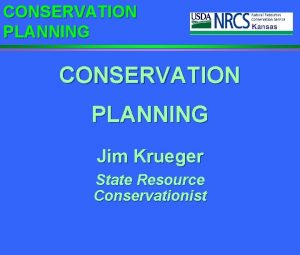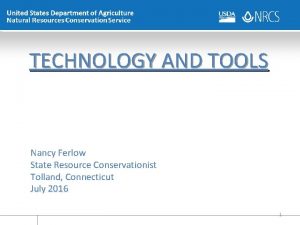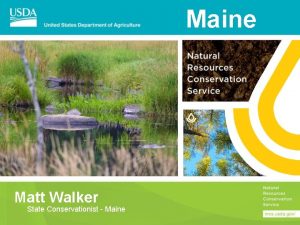EASEMENTS Lanette Dietrich Assistant State Conservationist Easement Program





















- Slides: 21

EASEMENTS Lanette Dietrich, Assistant State Conservationist – Easement Program lanette. dietrich@mn. usda. gov

EASEMENTS Program Updates Status Workload Monitoring Wetland Reserve Easement Cost List Evaluation (ranking) Geographic Area Rate Cap (GARC) Upland to Wetland Ratio Agricultural Land Easement Evaluation (ranking) Outreach

Program Status EWRP 26 2075 acres EWP-FPE 41 5604 acres WRP 937 112, 310 acres GRP 4 215 acres FRPP 57 6739 acres The general public may access NRCS geospatial data at the following Web address: http: //ncgcweb. ftw. nrcs. usda. gov/easements/imagery/. Available data includes the program name, easement boundaries, centroids, and State or county boundaries.

Workload WRP 33 3620 acres WRE 4 786 acres FRPP 370 acres ALE 3 439 acres FY 14 1 accepted September and will close October FY 15 9 offers; accepted 3 for 155 acres

Workload Counties Freeborn 97 68567 acres Stevens 61 6462 acres Dakota 57 6739 acres Marshall 51 8248 acres Kandiyohi 49 2925 acres Becker 45 4104 acres Blue Earth 44 2129 acres Steele 41 3454 acres Clay 36 6232 acres Polk 34 26180 acres

Easement Monitoring Requirements Annual Monitoring on Easements Four types of monitoring 1. Summary Review 2. Onsite 3. Landowner Review 4. Offsite 5 Year Cycle Onsite, Landowner Review, Offsite, Offsite

Easement Monitoring BY 15 by the numbers. . . 1006 Easements 268 On-site 122 Off-site 320 Landowner reviews 296 Summary reviews 129 Potential violations

Easement Monitoring Common Violations Ø Encroachment Ø Trails, lanes, field roads Ø Structures (fence, blind, etc. )

ACEP-WRE and STC Recommending a list of eligible practices for ACEP-WRE (ii) Reviewing proposed geographic area rate caps for use in determining ACEP-WRE easement compensation values (iii) Evaluating unique wetland complexes within the State to determine if they are consistent with ACEP-WRE national eligibility criteria. Examples of unique wetland complexes include but are not limited to pocosins, prairie potholes, playas, vernal pools, fens, bogs, or ridge, and swale floodplain complexes

Cost List (See Cost List Handouts): Cost list will be reviewed yearly and updated as needed Solicit input from field and partners Review with NRCS technical and program expertise Attempt to address current costs and change in practice standards Possible Additions 2016? Conservation Cover (Monarch/pollinator emphasis) Tree Establishment (nut)

State Technical Committee and ACEP Federal agencies, State wildlife or agricultural agencies, conservation districts, and other entities with appropriate expertise may - Provide recommendations for ranking priority criteria, except if such partner is seeking or will seek financial assistance through ACEP, it may not provide recommendations on ACEP ranking priority criteria.

Ranking Determining eligibility for enrollment includes more than determining that land fits within a particular land category. NRCS also must determine that the land offered is capable of having historic wetland hydrology and hydrophytic vegetation restored In FY 2015, NRCS updated the ranking criteria to better identified historic conditions, restoration potential and planned conditions. FY 16? Changes in WRE ranking?

GARC Compensation is based on: 1. The fair market value of land by appraisal or area-wide market analysis/survey 2. A Geographic Area Rate Cap (GARC) 3. Landowner offer

GARC FY 2015 Appraisal A 10% reduction to reflect the value of the rights that the landowner retained. GARC is 90% of the fair market value determined by appraisal FY 15 offers ranged from $3615 to $4275 per acres

GARC FY 2016 Appraisal? A 10% reduction to reflect the value of the rights that the landowner retained? GARC is 90% of the fair market value determined by appraisal?

Upland to Wetland Ratio Eligible land Other lands Adjacent lands that. . . Contribute significantly to wetland functions and values Provide practical administration of the enrolled area Typically upland buffer and associated areas One-to-one match limitation by policy FY 15 6: 1 pothole 1: 1 floodplain FY 16?

Agricultural Land Easement (ALE) Purpose to protect the agricultural viability, and related conservation values of eligible land by limiting nonagricultural uses of that land and. . . protect grazing uses and related conservation values by restoring and conserving eligible land

State Technical Committee and ACEP Recommending additional land eligibility or prioritization parameters to focus ALE enrollment in highest priority areas of the State Ranking? Only state questions can be considered/changed/added. . . national questions are provided in policy (i. e. , no changes to national questions)

State Technical Committee and ACEP Recommending additional land eligibility or prioritization parameters to focus ALE enrollment in highest priority areas of the State

EASEMENTS Lanette Dietrich, Assistant State Conservationist – Easement Program lanette. dietrich@mn. usda. gov

21 The U. S. Department of Agriculture (USDA) prohibits discrimination in all its programs and activities on the basis of race, color, national origin, age, disability, and where applicable, sex, marital status, familial status, parental status, religion, sexual orientation, genetic information, political beliefs, reprisal, or because all or a part of an individual's income is derived from any public assistance program. (Not all prohibited bases apply to all programs. ) Persons with disabilities who require alternative means for communication of program information (Braille, large print, audiotape, etc. ) should contact USDA's TARGET Center at (202) 720 -2600 (voice and TDD). To file a complaint of discrimination write to USDA, Director, Office of Civil Rights, 1400 Independence Avenue, S. W. , Washington, D. C. 202509410 or call (800) 795 -3272 (voice) or (202) 720 -6382 (TDD). USDA is an equal opportunity provider and employer.
 Dominant and servient easements
Dominant and servient easements Dominant and servient easements
Dominant and servient easements Art conservationist salary
Art conservationist salary Conservationist vs preservationist apush
Conservationist vs preservationist apush Caohc certification
Caohc certification Non possessory estate
Non possessory estate Encumbrance meaning
Encumbrance meaning Fin 331 exam 1
Fin 331 exam 1 Prescriptive easement pennsylvania
Prescriptive easement pennsylvania Tce easement
Tce easement Dietrich sabine
Dietrich sabine Madeleine dietrich
Madeleine dietrich Red bull geschichte
Red bull geschichte Head-of-wall
Head-of-wall Dietrich beitzke
Dietrich beitzke Yannick dietrich
Yannick dietrich Constanze dietrich
Constanze dietrich Dietrich belitz
Dietrich belitz Nvperf
Nvperf Yannick dietrich
Yannick dietrich Hcv
Hcv Anderson dietrich
Anderson dietrich
